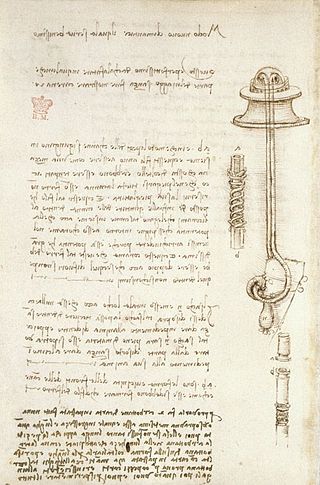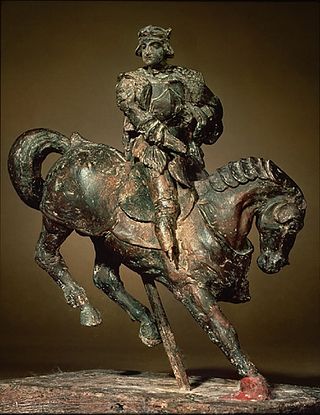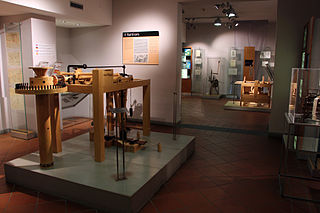
Leonardo di ser Piero da Vinci was an Italian polymath of the High Renaissance who was active as a painter, draughtsman, engineer, scientist, theorist, sculptor, and architect. While his fame initially rested on his achievements as a painter, he has also become known for his notebooks, in which he made drawings and notes on a variety of subjects, including anatomy, astronomy, botany, cartography, painting, and paleontology. Leonardo epitomized the Renaissance humanist ideal, and his collective works comprise a contribution to later generations of artists matched only by that of his younger contemporary Michelangelo.

Christie's is a British auction house founded in 1766 by James Christie. Its main premises are on King Street, St James's in London, and it has additional salerooms in New York, Paris, Hong Kong, Milan, Amsterdam, Geneva, Shanghai, and Dubai. It is owned by Groupe Artémis, the holding company of François Pinault. In 2022 Christie's sold US$8.4 billion in art and luxury goods, an all-time high for any auction house. On 15 November 2017, the Salvator Mundi was sold at Christie's in New York for $450 million to Saudi Prince Badr bin Abdullah bin Mohammed bin Farhan al-Saud, the highest price ever paid for a painting.

The Vitruvian Man is a drawing by the Italian Renaissance artist and scientist Leonardo da Vinci, dated to c. 1490. Inspired by the writings of the ancient Roman architect Vitruvius, the drawing depicts a nude man in two superimposed positions with his arms and legs apart and inscribed in both a circle and square. It was described by the art historian Carmen C. Bambach as "justly ranked among the all-time iconic images of Western civilization". Although not the only known drawing of a man inspired by the writings of Vitruvius, the work is a unique synthesis of artistic and scientific ideals and often considered an archetypal representation of the High Renaissance.

Museo Galileo is located in Florence, Italy, in Piazza dei Giudici, along the River Arno and close to the Uffizi Gallery. The museum, dedicated to astronomer and scientist Galileo Galilei, is housed in Palazzo Castellani, an 11th-century building which was then known as the Castello d'Altafronte.

The Codex Trivulzianus is a manuscript by Leonardo da Vinci that originally contained 62 sheets, but today only 55 remain. It documents Leonardo's attempts to improve his modest literary education, through long lists of learned words copied from authoritative lexical and grammatical sources. The manuscript also contains studies of military and religious architecture.

Leonardo da Vinci (1452–1519) was an Italian polymath, regarded as the epitome of the "Renaissance Man", displaying skills in numerous diverse areas of study. While most famous for his paintings such as the Mona Lisa and the Last Supper, Leonardo is also renowned in the fields of civil engineering, chemistry, geology, geometry, hydrodynamics, mathematics, mechanical engineering, optics, physics, pyrotechnics, and zoology.

The Gospels of Henry the Lion were intended by Henry the Lion, Duke of Saxony, for the altar of the Virgin Mary in the church of St. Blaise's Abbey, Brunswick, better known as Brunswick Cathedral. The volume is considered a masterpiece of Romanesque book illumination of the 12th century.

The Codex Atlanticus is a 12-volume, bound set of drawings and writings by Leonardo da Vinci, the largest single set. Its name indicates the large paper used to preserve original Leonardo notebook pages, which was used for atlases. It comprises 1,119 leaves dating from 1478 to 1519, the contents covering a great variety of subjects, from flight to weaponry to musical instruments and from mathematics to botany. This codex was gathered in the late 16th century by the sculptor Pompeo Leoni, who dismembered some of Leonardo's notebooks in its formation. It is now in the Biblioteca Ambrosiana in Milan.

Codex on the Flight of Birds is a relatively short codex from c. 1505 by Leonardo da Vinci.

La Bella Principessa, also known as Portrait of Bianca Sforza, Young Girl in Profile in Renaissance Dress and Portrait of a Young Fiancée, is a portrait in coloured chalks and ink, on vellum, of a young lady in fashionable costume and hairstyle of a Milanese of the 1490s. Some scholars have attributed it to Leonardo da Vinci but the attribution and the work's authenticity have been disputed. Supporters of the theory that it was by Leonardo have propositioned that Bianca Maria Sforza is the woman depicted in the drawing.

Codex Arundel, is a bound collection of pages of notes written by Leonardo da Vinci and dating mostly from between 1480 and 1518. The codex contains a number of treatises on a variety of subjects, including mechanics and geometry. The name of the codex came from the Earl of Arundel, who acquired it in Spain in the 1630s. It forms part of the British Library Arundel Manuscripts.
Carlo Pedretti was an Italian historian. In his lifetime, he was considered one of the world's leading experts on the life and works of Leonardo da Vinci. He was a professor of art history and Armand Hammer Chair in Leonardo Studies at the University of California, Los Angeles from 1960 until his retirement in 1993.

Salvator Mundi is a painting attributed in whole or in part to the Italian High Renaissance artist Leonardo da Vinci, dated to c. 1499–1510. Long thought to be a copy of a lost original veiled with overpainting, it was rediscovered, restored, and included in an exhibition of Leonardo's work at the National Gallery, London, in 2011–2012. Christie's, who sold the work in 2017, stated that most leading scholars consider it an original work by Leonardo, but this attribution has been disputed by other leading specialists, some of whom propose that he only contributed certain elements; and others who believe that the extensive restoration prevents a definitive attribution.

Victoria Blyth Hill was an American art conservator who lived and worked in the Venice area of Los Angeles. She retired from the Los Angeles County Museum of Art as the Director, Conservation Center in June 2005 when she was honored with an appointment as Senior Conservator Emeritus at the Los Angeles County Museum of Art (LACMA). Subsequently she worked with private clients, including artists, individuals, and museums, and operated an art conservation studio near her home. She was a past president of the Western Association for Art Conservation (1979). Blyth-Hill was elected Fellow of the American Institute for Conservation of Historic and Artistic Works (AIC) in 1990.
Carlo Vecce is Professor of Italian Literature in the University of Naples "L'Orientale", he taught also in the University of Pavia, the D'Annunzio University of Chieti–Pescara and the University of Macerata. Abroad he was visiting professor at Paris 3 (2001) and University of California Los Angeles (UCLA) (2009).

Horse and Rider is a beeswax sculpture depicting a rider on a horse. The history of the sculpture is unknown before the 20th century. The work has been attributed to Leonardo da Vinci by the Italian art historian Carlo Pedretti, though most historians have ignored or denied the attribution. A number of casts have been made, using a mold taken from the wax original.

The Museo Ideale Leonardo da Vinci is located in Vinci, Leonardo da Vinci's birthplace, in the province of Florence, Italy. It is part of the Museo leonardiano di Vinci.

Head of a Bear is a drawing study made by Leonardo da Vinci circa 1480. It is small in scale, measuring only 7 by 7 centimetres, and is rendered in silverpoint pencil. It is thought to be part of a study of animals that Leonardo made in this period. The artist may have drawn upon this study when painting the head of the animal in his Lady with an Ermine of 1489–1490. The drawing was owned by the British painter Sir Thomas Lawrence in the 18th century and by the art collector Norman Colville in the early 20th century. The American billionaire Thomas Kaplan purchased the drawing in 2008. It sold in 2021 for a total of £8.8 million, a record for a drawing by Leonardo.
















